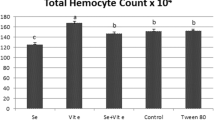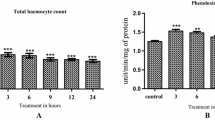Abstract
In intestine of larvae Galleria mellonella L. (Lepidoptera, Pyralidae) there were revealed changes of activities of enzymatic antioxidants—superoxide dismutase (SOD), glutathione S-transferase (GT), and catalase and of concentrations of non-enzymatic antioxidants—oxidized and reduced thiols (RSSR/RSH) during development of bacterial infection caused by bacteria Bacillus thuringiensis ssp. galleriae, strain 69-6 (BT). An increase of the activities of SOD and GT as well as of the ratio of oxidized to reduced thiols were shown alongside with a decrease of catalase activity in larvae infestated with BT during the experiment. This seems to be due to that during the pathological process, changes of the ratio of components of antioxidant system take place. It is suggested that changes in the antioxidant system of larvae G. mellonella can occur during the “oxidative stress” accompanying destructive processes in the intestine at the period of development of bacterial infection.
Similar content being viewed by others
REFERENCES
Zenkov, N.K., Lankin, V.Z., and Men’shchikova, E.B., Okislitel’nyi stress: biokhimicheskii i patofiziologicheskii aspekty (Oxidative Stress: Biochemical and Pathophysiological Aspects), Moscow, 2001.
Yankovskii, O.Yu., Toksichnost’kisloroda i biologicheskie sistemy (evolyutsionnye, ekologicheskie i mediko-biologicheskie aspekty) (Toxicity of Oxygen and Biological Systems (Evolutionary, Ecological, and Medico-Biological Aspects)), St. Petersburg, 2000.
Wan, Y., Oberley, L.W., and Murhammer, D.W., Antioxidant Defense Systems of Two Lepidopteran Insect Cell Lines, Free Radical Biol. Med., 2001, vol. 30, pp. 1254–1262.
Felton, G.W. and Summers, C.B., Antioxidant Systems in Insects, Arch. Insect Biochem. Physiol., 1995, vol. 2, pp. 187–197.
Barbehenn, R.V., Gut-Based Antioxidant Enzymes in a Polyphagous and a Graminivorous Grasshopper, J. Chem. Ecol., 2002, vol. 28, pp. 1329–1347.
Udupi, V. and Rice-Evans, C., Thiol Compounds as Protective Agents in Erythrocyte under Oxidative Stress, Free Radical Res. Commun., 1992, vol. 16, pp. 315–323.
Rahman, I. and Macnee, W., Regulation of Redox Glutathione Levels and Gene Transcription in Lung Inflammation: Therapeutic Approaches, Free Radical Biol. Med., 2000, vol. 28, pp. 1405–1420.
Wang, Y., Oberley, L.W., and Murhammer, D.W., Evidence of Oxidative Stress Following the Viral Infestation of Two Lepidopteran Insect Cell Lines, Free Radical Biol. Med., 2001, vol. 31, pp. 1448–1455.
Khodr, B. and Khalil, Z., Modulation of Inflammation by Reactive Oxygen Species: Implications for Aging and Tissue Repair, Free Radical Biol. Med., 2001, vol. 30, pp. 1–8.
Mehta, A., Singh, S., Dhawan, V., and Ganguly, K.N., Intestinal Mucosal Lipid Peroxidation and Absorptive Function in Salmonella typhimurium Mediated Intestinal Infestation, Mol. Cell. Biochem., 1998, vol. 178, pp. 345–352.
Pavlick, K.P., Laroux, F.S., Fuseler, J., Wolf, R.E., Gray, L., Hoffman, J., and Grisham, M.B., Role of Reactive Metabolites of Oxygen and Nitrogen in Inflammatory Bowel Disease, Free Radical Biol. Med., 2002, vol. 33, pp. 311–322.
Paes, M.C., Oliveira, M.B., and Oliveira, P.L., Hydrogen Peroxide Detoxification in the Midgut of the Blood-Sucking Insect Rhodnius prolixus, Arch. Insect. Biochem. Physiol., 2001, vol. 48, pp. 63–71.
Yu, S.J., Induction of New Gluthatione S-Transferase Isozymes by Allelochemicals in the Fall Armyworm, Pestic. Biochem. Physiol., 1999, vol. 63, pp. 163–171.
Nappi, A.J. and Vass, E., Hydrogen Peroxide Production in Immune-Reactive Drosophila melanogaster, J. Parasitol., 1998, vol. 84, pp. 1150–1157.
Barbehenn, R.V., Bumgarner, S.L., Roosen, E.F., and Martin, M.M., Antioxidant Defenses in Caterpillars: Role of the Ascorbate-Recycling System in the Midgut Lumen, J. Insect Physiol., 2001, vol. 47, pp. 349–357.
Habig, W.H., Pabst, M.J., and Jakoby, W.B., Glutathione-S-Transferases, J. Biol. Chem., 1974, vol. 249, pp. 7130–7139.
Missirlis, F., Phillips, J.P., and Jackle, H., Cooperative Action of Antioxidant Defense Systems in Drosophila, Current Biology, 2001, vol. 11, pp. 1272–1277.
Choi, G.J., Lee, H.J., and Cho, K.Y., Involvement of Catalase and Superoxide Dismutase in Resistance of Botyitis cinerea to Dicarboximide Fungicide Vinclozolin, Pestic. Biohem. Physiol., 1997, vol. 59, pp. 1–10.
Peric-Mataruga, V., Blagojevic, D., Spasic, M. B., Ivanovic, J., and Jankovic-Hladni, M., Effect of the Host Plant on the Antioxidative Defense in the Midgut of Lymantria dispar L. Caterpillars of Population Origins, J. Insect. Physiol., 1996, vol. 43, pp. 101–106.
Lozinskaya, A.L., Slepneva, I.A., Khramtsov, V.V., and Glupov, V.V., Change of Antioxidant Status and System of Generation of Free Radicals in Hemolymph of Galleria mellonella Larvae in Microsporidiosis, Zh. Evol. Biokhim. Fiziol., 2004, vol. 40, pp. 99–103.
Arking, R., Burde, V., Graves, K., Hari, R., Feldman, E., Zeevi, A., Soliman, S., Saraiya, A., Buck, S., Vettraino, J., and Sathrasala, K., Identical Longevity Phenotypes Are Characterized by Different Patterns of Gene Expression and Oxidative Damage, Exp. Gerontol., 2000, vol. 35, pp. 353–373.
Mockett, R.J., Orr, W.C., Rahmander, J.J., Sohal, B.H., and Sohal, R.S., Antioxidant Status and Stress Resistance in Long-and Short-Lived Lines of Drosophila melanogaster, Exp. Gerontol., 2001, vol. 36, pp. 411–630.
Tamarina, N.A., Technical Entomology—A New Sphere of Applied Entomology, Itogi nauku i tekhniki (Advances in Science and Technology), VINITI, Entomologiya, 1987, vol. 7, pp. 248–258.
Burtseva, L.I., Skvortsova, M.M., and Shashkina, N.I., On Selection of Strains Bac. thurindiensis var. galleriae for Producation of Entobacterin, Sib. Vest. Sel’khoz. Nauk, 1973, vol. 2, p.33.
McCord, J.M. and Fridovich, I., Superoxide Dismutase: An Enzymic Function for Erythrocuprein (Hemocuprein), J. Biol. Chem., 1969, vol. 244, pp. 6049–6055.
Khramtsov, V.V., Yelinova, V.I., Glazachev, Yu.I., Reznikov, V.A., Zimmer, G., Weiner, L., Berezina, T., Martin, V., and Volodarsky, L., Quantitative Determination and Reversible Modification of Thiols Using Imidazolidine Biradical Disulfide Label, J. Biochem. Biophys. Methods, 1997, vol. 35, pp. 115–128.
Khramtsov, V.V., Yelinova, V.I., Weiner, L., Berezina, T., Martin, V., and Volodarsky, L., Quantitative Determination of SH Groups in Low and High Molecular Weight Compounds by an EPR Method, Analytic. Biochem., 1989, vol. 182, pp. 58–63.
Bradford, M.M., A Rapid and Sensitive Method for the Quantitation of Microgram Quantities of Protein Utilizing the Principle of Protein Dye Binding, Anal. Biochem., 1976, vol. 72, pp. 248–254.
Dospekhov, B.A., Metodika polevogo opyta (s osnovami statisticheskoi obrabotki resul’tatov issledovanii) (Procedure of Field Experiment (with Grounds of Statistical Processing of Results of Studies)), Moscow, 1985.
Rausell, C., De Decker, N., Garcia-Robles, I., Escrihe, B., Van Kerkhove, E., Real, M.D., and Martinez-Ramirez, A.C., Effect of Bacillus thuringiensis Toxins on the Midgut of the Nun Moth Lymantria monacha, J. Invert. Pathol., 2000, vol. 75, pp. 288–291.
Gill, S.S., Cowles, E.A., and Pietrantonio, P.V., The Mode of Action of Bacillus thuringiensis Endotoxins, Annu. Rev. Entomol., 1992, vol. 37, pp. 661–636.
Yoshikawa, T., Takahashi, S., and Kondo, M., Possible Role of Free Radicals in the Chronic Inflammation of the Gut, EXS, 1992, vol. 62, pp. 353–368.
Shternshis, M.V., Povyshenie effektivnosti microbiologicheskoi bor’by s vrednymi nasekomymi (Increase of Effectiveness of Microbiological Fighting with Noxious Insects), Novosibirsk, 1995.
Author information
Authors and Affiliations
Additional information
Translated from Zhurnal Evolyutsionnoi Biokhimii i Fiziologii, Vol. 41, No. 1, 2005, pp. 18–22.
Original Russian Text Copyright © 2005 by Dubovskii, Olifirenko, Glupov.
Rights and permissions
About this article
Cite this article
Dubovskii, I.M., Olifirenko, O.A. & Glupov, V.V. Level and activities of antioxidants in intestine of larvae Galleria mellonella L. (Lepidoptera, Pyralidae) at peroral infestation by bacteria Bacillus thuringiensis ssp. galleriae . J Evol Biochem Phys 41, 20–25 (2005). https://doi.org/10.1007/s10893-005-0030-6
Received:
Issue Date:
DOI: https://doi.org/10.1007/s10893-005-0030-6




